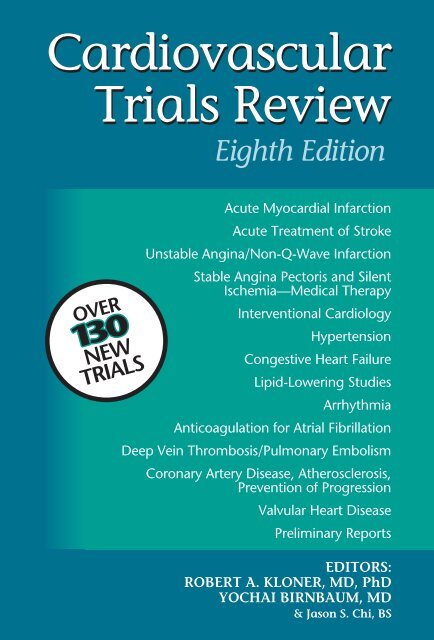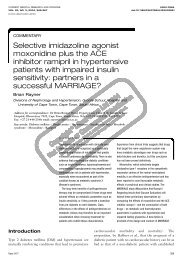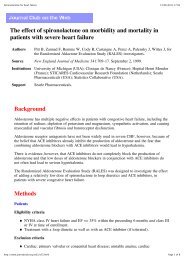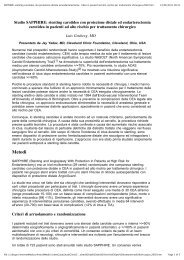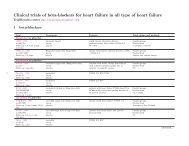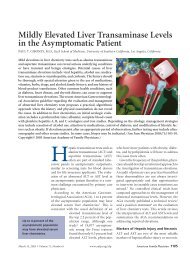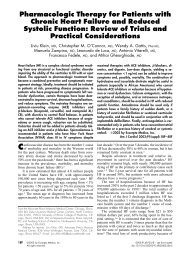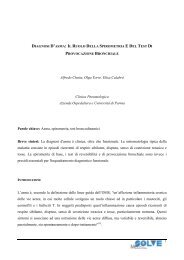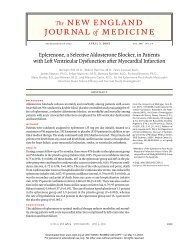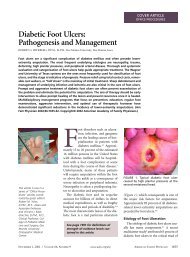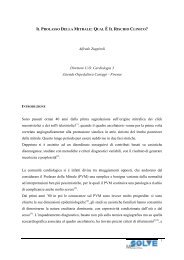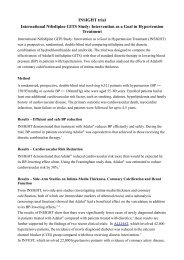Cardiovascular Trials Review Cardiovascular Trials Review - Diegori.it
Cardiovascular Trials Review Cardiovascular Trials Review - Diegori.it
Cardiovascular Trials Review Cardiovascular Trials Review - Diegori.it
Create successful ePaper yourself
Turn your PDF publications into a flip-book with our unique Google optimized e-Paper software.
<strong>Cardiovascular</strong><br />
<strong>Trials</strong> <strong>Review</strong><br />
Eighth Ed<strong>it</strong>ion<br />
Acute Myocardial Infarction<br />
Acute Treatment of Stroke<br />
Unstable Angina/Non-Q-Wave Infarction<br />
Stable Angina Pectoris and Silent<br />
Ischemia—Medical Therapy<br />
Interventional Cardiology<br />
Hypertension<br />
Congestive Heart Failure<br />
Lipid-Lowering Studies<br />
Arrhythmia<br />
Anticoagulation for Atrial Fibrillation<br />
Deep Vein Thrombosis/Pulmonary Embolism<br />
Coronary Artery Disease, Atherosclerosis,<br />
Prevention of Progression<br />
Valvular Heart Disease<br />
Preliminary Reports<br />
EDITORS:<br />
ROBERT A. KLONER, MD, PhD<br />
YOCHAI BIRNBAUM, MD<br />
& Jason S. Chi, BS
<strong>Cardiovascular</strong> <strong>Trials</strong> <strong>Review</strong><br />
8th Ed<strong>it</strong>ion<br />
Ed<strong>it</strong>ed by:<br />
Robert A. Kloner, MD, PhD<br />
Yochai Birnbaum, MD<br />
Studies compiled by:<br />
Robert A. Kloner, MD, PhD<br />
Yochai Birnbaum, MD<br />
Contributions by:<br />
Jason S. Chi, BS<br />
Robert A. Kloner, MD, PhD<br />
Director of Research, Heart Inst<strong>it</strong>ute,<br />
Good Samar<strong>it</strong>an Hosp<strong>it</strong>al<br />
Professor of Medicine, <strong>Cardiovascular</strong> Division<br />
Univers<strong>it</strong>y of Southern California<br />
Los Angeles, CA<br />
Yochai Birnbaum, MD<br />
Medical Director, Cardiac Intensive Care Un<strong>it</strong><br />
Medical Director, Heart Station<br />
Professor of Medicine,<br />
Division of Cardiology,<br />
Univers<strong>it</strong>y of Texas Medical Branch<br />
Galveston, TX<br />
Jason S. Chi, BS<br />
Univers<strong>it</strong>y of Illinois at Chicago<br />
College of Medicine, Chicago, IL
Dedicated to the memory of Philip Kloner<br />
1925–1997<br />
<strong>Cardiovascular</strong> <strong>Trials</strong> <strong>Review</strong>, 8th Ed<strong>it</strong>ion<br />
Copyright © 2003 by Le Jacq Communications, Inc.<br />
All rights reserved.<br />
1st Ed<strong>it</strong>ion Copyright © 1996, 2nd Ed<strong>it</strong>ion Copyright © 1997, 3rd Ed<strong>it</strong>ion<br />
Copyright © 1998, 4th Ed<strong>it</strong>ion Copyright © 1999, Millenium (5th) Ed<strong>it</strong>ion<br />
Copyright © 2000, 6th Ed<strong>it</strong>ion Copyright © 2001, 7th Ed<strong>it</strong>ion Copyright © 2002<br />
by Le Jacq Communications, Inc.<br />
Reproduction or translation of any part of this work w<strong>it</strong>hout permission<br />
of the copyright owner is unlawful. Requests for permission or further<br />
information should be addressed to the Permissions Department, Le Jacq<br />
Communications, Inc., 3 Parklands Drive, Darien, CT 06820.<br />
The facts, opinions, and ideas expressed in this book are those of the<br />
authors and do not necessarily reflect those of the publisher. The opinions<br />
and information presented in this book are attributed to the authors and not<br />
to the publisher. No responsibil<strong>it</strong>y is assumed by the publisher for any damage<br />
and/or injury of any nature occurring from any use, misuse, or omission<br />
of any of the information contained in this book.<br />
ISBN 1-929660-13-8<br />
Printed in the Un<strong>it</strong>ed States of America.<br />
ii<br />
Contents
Table of Contents<br />
Contents<br />
Subjects<br />
-v-<br />
<strong>Trials</strong> Listing<br />
-vii-<br />
Introduction<br />
-xxxiii-<br />
<strong>Trials</strong> 1<br />
<strong>Trials</strong> Index<br />
(in alphabetical order)<br />
1205<br />
Contents<br />
iii
Subjects<br />
Contents<br />
Section<br />
Page<br />
1. Acute Myocardial Infarction<br />
a. Thrombolytic Therapy 1<br />
b. Percutaneous Transluminal Coronary Angioplasty vs<br />
Stenting vs Thrombolytic Therapy<br />
31<br />
c. Anticoagulation/Antiplatelet 71<br />
d. Early vs Late Intervention After Acute Myocardial Infarction 139<br />
e. Remodeling After Infarction 143<br />
f. Miscellaneous and Adjunctive Therapy 157<br />
2. Acute Treatment of Stroke 193<br />
3. Unstable Angina/Non-Q-Wave Infarction/Non-ST-Elevation 207<br />
Myocardial Infarction or Acute Coronary Syndrome<br />
4. Stable Angina Pectoris and Silent Ischemia—Medical Therapy 307<br />
5. Interventional Cardiology<br />
a. Percutaneous Transluminal Coronary Angioplasty<br />
(and/or stenting) vs Coronary Artery Bypass Graft Surgery<br />
339<br />
b. Percutaneous Transluminal Coronary Angioplasty vs Stenting<br />
vs Other Percutaneous Devices, IVUS Guided Stenting<br />
367<br />
c. Medical Therapy, Brachytherapy, Drug-Eluting Stents to 467<br />
Prevent Restenosis and/or Complications After Intracoronary<br />
Interventions or Occlusion After Coronary Artery Bypass Grafting<br />
d. Other Therapy Including Transmyocardial Laser Revascularization 595<br />
6. Hypertension 615<br />
7. Congestive Heart Failure 697<br />
8. Lipid-Lowering Studies 783<br />
9. Arrhythmia 905<br />
Contents<br />
v
Section<br />
Page<br />
10. Anticoagulation for Atrial Fibrillation 1009<br />
11. Deep Vein Thrombosis/ Pulmonary Embolism 1019<br />
12. Coronary Artery Disease, Atherosclerosis, 1055<br />
Prevention of Progression<br />
13. Valvular Heart Disease 1145<br />
14. Preliminary Reports<br />
a. Acute Myocardial Infarction 1157<br />
b. Unstable Angina, Non-Q-Wave Myocardial Infarction 1163<br />
c. Hypertension 1169<br />
d. Congestive Heart Failure 1173<br />
e. Arrhythmia 1181<br />
f. Interventional Cardiology 1189<br />
vi<br />
Contents
Page<br />
Acronym/T<strong>it</strong>le<br />
<strong>Trials</strong> Listing<br />
Contents<br />
1a. Acute Myocardial Infarction — Thrombolytic Therapy<br />
2 GUSTO-III (1 Year) – Global Utilization of Streptokinase and tPA for<br />
Occluded Coronary Arteries-III<br />
4 SPEED (GUSTO-IV Pilot) – Early Percutaneous Coronary Intervention<br />
Strategies for Patency Enhancement in the Emergency Department.<br />
Global Use of Strategies to Open Occluded Coronary Arteries IV<br />
6 SPEED – Strategies for Patency Enhancement in the Emergency<br />
Department. Global Use of Strategies to Open Occluded Arteries<br />
(GUSTO-IV Pilot)<br />
8 GUSTO V – Global Utilization of Strategies to Open Occluded<br />
Coronary Arteries V<br />
11 GUSTO V – Global Utilization of Strategies to Open Occluded<br />
Coronary Arteries V<br />
13 TIMI-4 – Thrombolysis in Myocardial Infarction-4<br />
15 InTIME-II – Intravenous nPA for Treatment of Infarcting Myocardium<br />
Early-II<br />
18 ASSENT (Substudy) – Assessment of the Safety and Efficacy of a New<br />
Thrombolytic Agent<br />
20 ASSENT-2 – Assessment of the Safety and Efficacy of a New Thrombolytic-2<br />
22 ASSENT-3 – Assessment of the Safety and Efficacy of a New Thrombolytic<br />
Regimen-3<br />
25 TUCC – Randomized Trial Confirming the Efficacy of Reduced Dose<br />
Recombinant Tissue Plasminogen Activator in a Chinese Myocardial<br />
Infarction Population and Demonstrating Superior<strong>it</strong>y to Usual Dose<br />
Urokinase<br />
27 ER-TIMI – Results of the Early Retavase-Thrombolysis In Myocardial<br />
Infarction (ER-TIMI) 19 Trial<br />
1b. Acute Myocardial Infarction — Percutaneous<br />
Transluminal Coronary Angioplasty vs Stenting vs<br />
Thrombolytic Therapy<br />
32 Stent-PAMI – Stent-Primary Angioplasty in Myocardial Infarction<br />
34 Long-Term Benef<strong>it</strong> of Primary Angioplasty as Compared w<strong>it</strong>h<br />
Thrombolytic Therapy for Acute Myocardial Infarction<br />
Contents<br />
vii
Page<br />
Acronym/T<strong>it</strong>le<br />
36 PACT – Plasminogen Activator Angioplasty Compatibil<strong>it</strong>y Trial<br />
38 CCP – Cooperative <strong>Cardiovascular</strong> Project<br />
40 PRAGUE – Primary Angioplasty in Patients Transferred from General<br />
Commun<strong>it</strong>y Hosp<strong>it</strong>als to Specialized PTCA Un<strong>it</strong>s w<strong>it</strong>h or W<strong>it</strong>hout<br />
Emergency Thrombolysis<br />
43 STOPAMI – Stent vs Thrombolysis for Occluded Coronary Arteries in<br />
Patients w<strong>it</strong>h Acute Myocardial Infarction<br />
45 STAT – Stenting vs Thrombolysis in Acute Myocardial Trial<br />
47 SHOCK – Should We Emergently Revascularize Occluded Coronaries<br />
for Cardiogenic Shock<br />
50 Stenting vs Balloon Angioplasty for Acute Myocardial Infarction<br />
52 Randomized Comparison of Direct Stenting w<strong>it</strong>h Conventional Stent<br />
Implantation in Selected Patients w<strong>it</strong>h Acute Myocardial Infarction<br />
54 STENTIM-2 – Stenting in Acute Myocardial Infarction-2<br />
57 C-PORT – The Atlantic <strong>Cardiovascular</strong> Patient Outcomes Research<br />
Team<br />
59 TIMI Frame Count<br />
61 Air PAMI – Air Primary Angioplasty in Myocardial Infarction Study<br />
63 Randomized Comparison of Primary Angioplasty and Thrombolytic<br />
Therapy<br />
65 CAPTIM – Comparison of Angioplasty and Prehosp<strong>it</strong>al Thrombolysis<br />
in Acute Myocardial Infarction<br />
68 PRAGUE-2 – Primary Angioplasty in Patients Transported from<br />
General Commun<strong>it</strong>y Hosp<strong>it</strong>als to Specialized PTCA Un<strong>it</strong>s w<strong>it</strong>h or<br />
W<strong>it</strong>hout Emergency Thrombolysis-2<br />
1c. Acute Myocardial Infarction — Anticoagulation/<br />
Antiplatelet<br />
72 CARS (Substudy) – Coumadin Aspirin Reinfarction Study (Substudy)<br />
74 TIMI-14 (Substudy) – Thrombolysis in Myocardial Infarction-14<br />
76 MINT – Myocardial Infarction w<strong>it</strong>h Novastan and tPA<br />
78 ESCALAT – Efegatran and Streptokinase to Canalize Arteries Like<br />
Accelerated Tissue Plasminogen Activator<br />
81 ISAR-2 – Intracoronary Stenting and Ant<strong>it</strong>hrombotic Regimen-2<br />
83 HEAP – Heparin in Early Patency<br />
viii<br />
Contents
Page<br />
Acronym/T<strong>it</strong>le<br />
Contents<br />
85 HIT-4 – Hirudin for the Improvement of Thrombolysis-4<br />
87 TIM – Triflusal in Myocardial Infarction<br />
89 Eptifibatide vs Placebo in Patients Receiving Thrombolytic Therapy<br />
91 JAMIS – Japanese Antiplatelet Myocardial Infarction Study<br />
93 STAMI – Study of Ticlopidine vs Aspirin in Myocardial Infarction<br />
95 ADMIRAL – Abciximab Before Direct Angioplasty and Stenting in<br />
Myocardial Infarction Regarding Acute and Long-Term Follow-Up<br />
98 INTRO AMI – Integrilin and Low-Dose Thrombolysis in Acute<br />
Myocardial Infarction Study<br />
100 CHAMP – Combination Hemotherapy and Mortal<strong>it</strong>y Prevention<br />
102 HART II – Second Trial of Heparin and Aspirin Reperfusion Therapy<br />
104 ENTIRE-TIMI-23 – Enoxaparin and TNK-tPA W<strong>it</strong>h or W<strong>it</strong>hout GP<br />
IIIb/IIIa Inhib<strong>it</strong>or as Reperfusion Strategy in ST Evaluation MI—<br />
Thrombolysis in Myocardial Infarction-23<br />
106 HERO-2 – Hirulog and Early Reperfusion or Occlusion-2 Trial<br />
108 PENTALYSE – Pentasaccharide, as an Adjunct to Fibrinolysis in ST<br />
Elevation Acute Myocardial Infarction<br />
111 CADILLAC – Controlled Abciximab and Device Investigation to Lower<br />
Late Angioplasty Complications<br />
115 PRIME – Promotion of Reperfusion in Myocardial Infarction Evolution<br />
118 VITAL – Vasoflux International Trial for Acute Myocardial Infarction<br />
Lysis<br />
120 Enoxaparin vs Unfractionated Heparin After Thrombolytic Therapy for<br />
Acute Myocardial Infarction<br />
122 ASPECT-2 – Ant<strong>it</strong>hrombotics in the Secondary Prevention of Events in<br />
Coronary Thrombosis-2<br />
124 AMI-SK – Acute Myocardial Infarction Streptokinase<br />
127 ASSENT Plus – Assessment of the Safety and Efficacy of a New<br />
Thrombolytic Plus<br />
129 TIGER-PA – Tirofiban Given in the Emergency Room Before Primary<br />
Angioplasty Pilot Trial<br />
131 Intracoronary vs Intravenous Abciximab in Acute Coronary Syndromes<br />
133 APRICOT-2 – Ant<strong>it</strong>hrombotics in the Prevention of Reocclusion in<br />
Coronary Thrombolysis Trial-2<br />
136 Warfarin, Aspirin, or Both After Myocardial Infarction<br />
Contents<br />
ix
Page<br />
Acronym/T<strong>it</strong>le<br />
1d. Acute Myocardial Infarction — Early vs Late Intervention<br />
After Acute Myocardial Infarction<br />
140 Early Revascularization in 14-Day Survivors of Acute Myocardial<br />
Infarction<br />
1e. Acute Myocardial Infarction — Remodeling After<br />
Infarction<br />
144 GISSI-3 Substudy – Gruppo Italiano per lo Studio della Sopravvivenza<br />
nell’Infarto Miocardico-3<br />
146 TRACE (Update) – Trandolapril Cardiac Evaluation<br />
148 TRACE (Diabetic Substudy) – Trandolapril Cardiac Evaluation Study<br />
150 CAPRICORN – Carvedilol Post-Infarct Survival Control in LV<br />
Dysfunction<br />
152 OPTIMAAL – Optimal Trial In Myocardial Infarction w<strong>it</strong>h the<br />
Angiotensin II Antagonist Losartan<br />
155 SMILE-2 – Survival of Myocardial Infarction Long-Term Evaluation-2<br />
1f. Acute Myocardial Infarction — Miscellaneous and<br />
Adjunctive Therapy<br />
158 DECREASE – Dutch Echocardiographic Cardiac Risk Evaluation<br />
Applying Stress Echocardiography Study Group<br />
160 NEHDP – National Exercise and Heart Disease Project<br />
162 AMISTAD – Acute Myocardial Infarction Study of Adenosine Trial<br />
164 INTERCEPT – Incomplete Infarction Trial of European Research<br />
Collaborators Evaluating Progress Post-Thrombolysis<br />
166 Cariporide in Patients w<strong>it</strong>h Acute Anterior Myocardial Infarction<br />
168 EMIP-FR – European Myocardial Infarction Project—Free Radicals<br />
170 LIMIT AMI – Lim<strong>it</strong>ation of Myocardial Infarction Following<br />
Thrombolysis in Acute Myocardial Infarction Study<br />
172 GISSI-Prevenzione Trial – Gruppo Italiano per lo Studio della<br />
Sopravvivenza nell’Infarto Miocardico<br />
174 GISSI-Prevenzione – Gruppo Italiano per lo Studio della<br />
Sopravvivenza nell’Infarto Miocardico—Prevenzione<br />
x<br />
Contents
Page<br />
Acronym/T<strong>it</strong>le<br />
Contents<br />
176 ESCAMI – Evaluation of the Safety and Cardioprotective Effects of<br />
Eniporide in Acute Myocardial Infarction<br />
179 Does Angina Pectoris the Week Before Protect Against First Acute<br />
Myocardial Infarction in Patients w<strong>it</strong>h Diabetes Mell<strong>it</strong>us<br />
181 HALT-MI – Hu23F2G Anti-Adhesion to Lim<strong>it</strong> Cytotoxic Injury<br />
Following AMI<br />
184 MAGIC – Magnesium in Coronaries<br />
186 FLORIDA – Fluvastatin on Risk Diminishment After Acute Myocardial<br />
Infarction<br />
189 SADHART – Sertraline Antidepressant Heart Attack Randomized Trial<br />
2. Acute Treatment of Stroke<br />
194 NINDS – Neurological Disorders and Stroke Recombinant Tissue<br />
Plasminogen Activator Stroke Study<br />
196 STAT – Stroke Treatment w<strong>it</strong>h Ancord Trial<br />
198 ATLANTIS – Alteplase Thrombolysis for Acute Noninterventional<br />
Therapy in Ischemic Stroke<br />
200 PROCAT II – Prolyse in Acute Cerebral Thromboembolism II<br />
203 Aptiganel Hydrochloride in Acute Ischemic Stroke<br />
205 WARSS – Warfarin Aspirin Recurrent Stroke Study<br />
3. Unstable Angina/Non-Q-Wave Infarction/<br />
Non-ST-Elevation Myocardial Infarction or Acute<br />
Coronary Syndrome<br />
208 HASI (Update) – Bivalirudin Angioplasty Study (Hirulog Angioplasty<br />
Study)<br />
211 PRISM-PLUS – Platelet Receptor Inhib<strong>it</strong>ion in Ischemic Syndrome<br />
Management in Patients Lim<strong>it</strong>ed by Unstable Signs and Symptoms<br />
213 PRISM-PLUS (Angiographic Results) – Platelet Receptor Inhib<strong>it</strong>ion<br />
for Ischemic Syndrome Management in Patients Lim<strong>it</strong>ed by Unstable<br />
Signs and Symptoms<br />
215 PRISM-PLUS (Diabetic Substudy) – Platelet Receptor Inhib<strong>it</strong>ion in<br />
Ischemic Syndrome Management in Patients Lim<strong>it</strong>ed by Unstable Signs<br />
and Symptoms<br />
Contents<br />
xi
Page<br />
Acronym/T<strong>it</strong>le<br />
217 VANQWISH Trial (Non-Q-Wave Myocardial Infarction Following<br />
Thrombolysis) – Veterans Affairs Non-Q-Wave Infarction Strategies<br />
In-Hosp<strong>it</strong>al<br />
219 PARAGON B – Platelet IIb/IIIa Antagonist for the Reduction of Acute<br />
Coronary Syndrome Events in a Global Organization Network B<br />
221 PARAGON B (Troponin T Substudy) – Platelet IIb/IIIa Antagonism<br />
for the Reduction of Acute Coronary Syndrome Events in a Global<br />
Organization Network<br />
223 PURSUIT – Platelet Glycoprotein IIb/IIIa in Unstable Angina: Receptor<br />
Suppression Using Integrilin Therapy<br />
225 PURSUIT (Substudy) – Platelet Glycoprotein IIb/IIIa in Unstable<br />
Angina: Receptor Suppression Using Integrilin Therapy<br />
227 PURSUIT (Substudy) – Platelet Glycoprotein IIb/IIIa in Unstable<br />
Angina: Receptor Suppression Using Integrilin Therapy<br />
229 PURSUIT (Substudy) – Platelet Glycoprotein IIb/IIIa in Unstable<br />
Angina: Receptor Suppression Using Integrilin Therapy<br />
231 PURSUIT (Subanalysis) – Platelet IIb/IIIa in Unstable Angina:<br />
Receptor Suppression Using Integrilin Therapy<br />
233 FRISC II – Fragmin and Fast Revascularisation During Instabil<strong>it</strong>y in<br />
Coronary Artery Disease II<br />
238 FRISC II (Substudy) – Fragmin and Fast Revascularization During<br />
Instabil<strong>it</strong>y in Coronary Artery Disease II<br />
240 FRAX.I.S – Fraxiparine in Ischemic Syndrome<br />
243 TIMI-11B – Thrombolysis in Myocardial Infarction-11B<br />
245 Randomized Trial Comparing IV N<strong>it</strong>roglycerin and Heparin for<br />
Treatment of Unstable Angina Secondary to Restenosis After Coronary<br />
Artery Angioplasty<br />
247 Efegatran in Unstable Angina<br />
250 SYMPHONY – Sibrafiban vs Aspirin to Yield Maximum Protection<br />
from Ischemic Heart Events Post-Acute Coronary Syndromes<br />
252 2nd SYMPHONY – Sibrafiban vs Aspirin to Yield Maximum Protection<br />
from Ischemic Heart Events Post-Acute Coronary Syndromes<br />
254 OPUS-TIMI-16 – Oral Glycoprotein IIb/IIIa Inhib<strong>it</strong>ion w<strong>it</strong>h Orbofiban<br />
in Patients w<strong>it</strong>h Unstable Coronary Syndromes<br />
256 ESSENCE (ST Segment Mon<strong>it</strong>oring Substudy) – Efficacy and Safety<br />
of Subcutaneous Enoxaparin in Non-Q-Wave Coronary Events<br />
258 ESSENCE (1-Year Results) – Efficacy and Safety of Subcutaneous<br />
Enoxaparin in Non-Q-Wave Coronary Events<br />
xii<br />
Contents
Page<br />
Acronym/T<strong>it</strong>le<br />
Contents<br />
260 APLAUD – Antiplatelet Useful Dose<br />
262 GUARDIAN – Guard During Ischemia Against Necrosis<br />
264 FROST – Fibrinogen Receptor Occupancy Study<br />
267 GUSTO IV-ACS – Global Utilization of Strategies to Open Occluded<br />
Coronary Arteries IV—Acute Coronary Syndromes<br />
270 GUSTO IV – Global Use of Strategies to Open Occluded Coronary<br />
Arteries IV—Acute Coronary Syndrome (1-Year Follow-Up)<br />
272 TACTICS-TIMI-18 – Treat Angina w<strong>it</strong>h Aggrastat and Determine Cost<br />
of Therapy w<strong>it</strong>h an Invasive or Conservative Strategy—Thrombolysis<br />
in Myocardial Infarction-18<br />
275 TACTICS-TIMI 18 (Substudy) – Treat Angina w<strong>it</strong>h Aggrastat and<br />
Determine Cost of Therapy w<strong>it</strong>h an Invasive or Conservative<br />
Strategy—Thrombolysis in Myocardial Infarction-18<br />
277 CURE – Clopidogrel in Unstable Angina to Prevent Recurrent Events<br />
280 CURE – Clopidogrel in Unstable Angina To Prevent Recurrent Events<br />
(Substudy)<br />
282 CURE – Clopidogrel in Unstable Angina to Prevent Recurrent Events<br />
Trial (Substudy)<br />
285 PCI-CURE – Clopidogrel in Unstable Angina to Prevent Recurrent<br />
Events—Percutaneous Coronary Intervention Substudy<br />
288 VINO – Value of First Day Coronary Angiography/Angioplasty in<br />
Evolving Non-ST Segment Elevation Myocardial Infarction. An Open<br />
Multicenter Randomized Trial<br />
290 ACE Inhib<strong>it</strong>ors in Acute Coronary Syndrome<br />
292 INTERACT – Integrilin and Enoxaparin Randomized Assessment of<br />
Acute Coronary Syndrome Treatment<br />
295 Women Do Have an Improved Long-Term Outcome After Non-ST-<br />
Elevation Acute Coronary Syndromes Treated Very Early and<br />
Predominantly w<strong>it</strong>h Percutaneous Coronary Intervention<br />
297 ACUTE 2 – Ant<strong>it</strong>hombolic Combination Using Tirofiban and Enoxaparin<br />
299 RITA 3 – Randomized Intervention Trial of Unstable Angina<br />
302 NUT-2 – The Nonsteroidal Anti-Inflammatory Drugs in Unstable Angina<br />
Treatment-2 Pilot Study<br />
305 AZACS – Az<strong>it</strong>hromycin in Acute Coronary Syndrome<br />
Contents<br />
xiii
Page<br />
Acronym/T<strong>it</strong>le<br />
4. Stable Angina Pectoris and Silent Ischemia—Medical<br />
Therapy<br />
308 EMIT – European Mivazerol Trial<br />
310 New Pharmacological Treatment for Interm<strong>it</strong>tent Claudication: Results<br />
of a Randomized, Multicenter Trial<br />
312 MUST-EECP – Multicenter Study of Enhanced External<br />
Counterpulsation<br />
314 QUO VADIS – Quinapril on Vascular ACE and Determinants of<br />
Ischemia<br />
316 PATCH – Program to Assess Alternative Treatment Strategies to<br />
Achieve Cardiac Health<br />
318 FIRST – FGF In<strong>it</strong>iating Revascularization Trial<br />
320 TRIMPOL II – Trimetazidine in Poland II<br />
322 PISA – Persantin in Stable Angina<br />
324 TIME – Trial of Invasive vs Medical Therapy in Elderly Patients<br />
326 IONA – Impact of Nicorandil in Angina<br />
328 Dutch Echocardiographic Cardiac Risk Evaluation Applying Stress<br />
Echocardiography<br />
330 Antianginal and Anti-Ischemic Effects of Ivabradine, an I f Inhib<strong>it</strong>or, in<br />
Stable Angina<br />
333 CAPE II Trial – Circadian Anti-Ischemic Program in Europe II<br />
336 Effects of Oral Magnesium Therapy on Exercise Tolerance, Exercise-<br />
Induced Chest Pain, and Qual<strong>it</strong>y of Life in Patients w<strong>it</strong>h Coronary<br />
Artery Disease<br />
5a. Interventional Cardiology — Percutaneous Transluminal<br />
Coronary Angioplasty (and/or stenting) vs Coronary<br />
Artery Bypass Graft Surgery<br />
340 Cogn<strong>it</strong>ive Outcome After Off-Pump and On-Pump Coronary Artery<br />
Bypass Graft Surgery. A Randomized Trial<br />
342 Octopus Study<br />
344 Octopus Study<br />
346 BHACAS (1 & 2) – Beating Heart Against Cardioplegic Arrest Studies<br />
1 & 2<br />
xiv<br />
Contents
Page<br />
Acronym/T<strong>it</strong>le<br />
Contents<br />
348 EAST (8-Year Mortal<strong>it</strong>y Data) – Emory Angioplasty vs Surgery Trial<br />
350 BARI (7-Year Outcome, Diabetics) – Bypass Angioplasty<br />
Revascularization Investigation<br />
352 Arterial Revascularization Therapies Study<br />
354 ERACI II – Argentine Randomized Trial of Percutaneous Transluminal<br />
Coronary Angioplasty vs Coronary Artery Bypass Surgery in Multivessel<br />
Disease II<br />
357 ARTS – Arterial Revascularization Therapy Study<br />
359 AWESOME – Angina w<strong>it</strong>h Extremely Serious Operative Mortal<strong>it</strong>y<br />
Evaluation<br />
361 Comparison of Stenting w<strong>it</strong>h Minimally Invasive Bypass Surgery for<br />
Stenosis of the Left Anterior Descending Coronary Artery<br />
364 SOS – Stent or Surgery<br />
5b. Interventional Cardiology — Percutaneous Transluminal<br />
Coronary Angioplasty vs Stenting vs Other Percutaneous<br />
Devices, IVUS Guided Stenting<br />
368 BENESTENT-I (5-Year Follow-Up) – Belgium Netherlands Stent<br />
370 STRESS (Diabetic Substudy) – Stent Restenosis Study<br />
372 TOSCA – Total Occlusion Study of Canada<br />
374 START (Stent vs Atherectomy) – Stent vs Directional Coronary<br />
Atherectomy Randomized Trial<br />
376 START (Stenting vs PTCA) – Stent Implantation and Balloon<br />
Angioplasty in the Treatment of De Novo Coronary Artery Lesions<br />
378 ABACAS – Adjunctive Balloon Angioplasty After Coronary<br />
Atherectomy Study<br />
380 FROST – French Randomized Optimal Stenting Trial<br />
382 Comparison of GR-II Stent and Palmaz-Schatz Stent<br />
384 CRUISE – Can Routine Ultrasound Influence Stent Expansion<br />
386 COBRA – Comparison of Balloon Angioplasty vs Rotational<br />
Atherectomy<br />
388 PARAGON Stent Study – Platelet IIb/IIIa Antagonism for the<br />
Reduction of Acute Coronary Syndrome Events in a Global<br />
Organization Network<br />
390 Stent Implantation in Small Coronary Arteries<br />
Contents<br />
xv
Page<br />
Acronym/T<strong>it</strong>le<br />
392 High-Pressure Stenting vs Balloon Angioplasty<br />
394 NIRVANA – NIR Vascular Advanced North American Trial<br />
396 STRATAS – Study to Determine Rotablator and Transluminal<br />
Angioplasty Strategy<br />
399 BET – Benef<strong>it</strong> Evaluation of Direct Coronary Stenting<br />
401 BET – Benef<strong>it</strong> Evaluation of Direct Coronary Stenting<br />
403 ASCENT – ACS MultiLink Stent Clinical Equivalence in De Novo<br />
Lesions Trial<br />
405 DESTINI – Doppler End Point Stenting International Investigation<br />
407 DEBATE II – Doppler End Points Balloon Angioplasty Trial Europe II<br />
409 DEBATE II (Substudy) – Doppler End Points Balloon Angioplasty<br />
Trial Europe II<br />
411 ISAR-SMART – Intracoronary Stenting or Angioplasty for Restenosis<br />
Reduction in Small Arteries<br />
413 ISAR-SMART Trial (Substudy) – Intracoronary Stenting or<br />
Angioplasty for Restenosis Reduction in Small Arteries<br />
415 WIDEST – Wiktor Stent in De Novo Stenosis<br />
417 OPUS-1 – Optimum Percutaneous Transluminal Coronary Angioplasty<br />
vs Routine Stenting-1<br />
419 ADVANCE – Add<strong>it</strong>ional Value of NIR Stents for Treatment of Long<br />
Coronary Lesions<br />
421 ARTIST – Angioplasty vs Rotational Atherectomy for Treatment of<br />
Diffuse In-Stent Restenosis Trial<br />
423 ARTIST (Substudy) – Angioplasty Versus Rotational Atherectomy for<br />
the Treatment of Diffuse In-Stent Restenosis Trial<br />
425 SISA – Stent in Small Arteries<br />
427 OPTICUS – Optimization w<strong>it</strong>h ICUS (Intracoronary Ultrasound) to<br />
Reduce Stent Restenosis<br />
429 Cutting Balloon Angioplasty<br />
431 SCORES – Stent Comparative Restenosis<br />
433 BESMART – Bestent in Small Arteries<br />
435 SAFE – Saphenous Vein Graft Angioplasty Free of Emboli<br />
437 Magic 5L – Magic 5L Wallstent Study<br />
439 CAPAS – Cutting Balloon Angioplasty vs Plain Old Balloon Angioplasty<br />
Randomized Study in Type B/C Lesions<br />
441 SISCA – Stenting in Small Coronary Arteries<br />
xvi<br />
Contents
Page<br />
Acronym/T<strong>it</strong>le<br />
Contents<br />
443 PREDICT – Predilatation vs Direct Stenting in Coronary Treatment<br />
446 DIRECT – Comparison of Direct Stenting vs Stenting w<strong>it</strong>h Predilation<br />
for the Treatment of Selected Coronary Narrowings<br />
449 SWIBAP – Stent W<strong>it</strong>hout Balloon Predilation<br />
452 Cutting Balloon Global Randomized Trial<br />
455 Direct Coronary Stenting Versus Predilatation Followed by Stent<br />
Placement<br />
458 ISAR-STEREO-2 – Intracoronary Stenting and Angiographic Results:<br />
Strut Thickness Effect on Restenosis Outcome Trial<br />
460 DANSTENT – The Danish Multicenter Stent Study<br />
462 TENISS – The Tenax vs NIR Stent Study<br />
464 MultiLink Long Stents for Long Coronary Lesions<br />
5c. Interventional Cardiology — Medical Therapy,<br />
Brachytherapy, Drug-Eluting Stents to Prevent Restenosis<br />
and/or Complications After Intracoronary Interventions<br />
or Occlusion After Coronary Artery Bypass Grafting<br />
468 IMPACT-II (Substudy) – Integrilin to Minimize Platelet Aggregation<br />
and Coronary Thrombosis-II<br />
470 EPISTENT – Evaluation of Platelet IIb/IIIa Inhib<strong>it</strong>ion in Stenting<br />
472 EPISTENT (6-Month Outcome) – Evaluation of Platelet IIb/IIIa<br />
Inhib<strong>it</strong>ion in Stenting<br />
474 EPISTENT (Diabetic Substudy) – Evaluation of Platelet IIb/IIIa<br />
Inhib<strong>it</strong>ion in Stenting<br />
476 ERASER – The Evaluation of ReoPro and Stenting to Eliminate<br />
Restenosis<br />
478 3-Year Clinical and Angiographic Follow-Up After Intracoronary<br />
Radiation<br />
480 VIP – Visipaque in Percutaneous Transluminal Coronary Angioplasty<br />
482 EXCITE – Evaluation of Oral Xemilofiban in Controlling Thrombotic<br />
Events<br />
484 Clopidogrel as Adjunctive Antiplatelet Therapy During Coronary<br />
Stenting<br />
486 Clopidogrel vs Ticlopidine After Intracoronary Stent Placement<br />
488 Minimal Heparinization in Coronary Angioplasty<br />
Contents<br />
xvii
Page<br />
Acronym/T<strong>it</strong>le<br />
490 TREAT – Tranilast Restenosis Following Angioplasty Trial<br />
492 TREAT-2 – Tranilast Restenosis Angioplasty Trial-2<br />
495 CAPARES – Coronary Angioplasty Amlodipine Restenosis Study<br />
498 WRIST – Washington Radiation for In-Stent Restenosis Trial<br />
500 COURT – Contrast Media Utilization in High-Risk PTCA<br />
502 Gamma-1 Trial<br />
504 Gamma-1 Study (Intravascular Ultrasound Analysis)<br />
506 β-Radiation Therapy—Dose-Finding Study<br />
508 CLASSICS – Clopidogrel Aspirin Stent International Cooperative Study<br />
510 PREVENT (Radiotherapy) – Proliferation Reduction w<strong>it</strong>h Vascular<br />
Energy Trial<br />
512 ESPRIT – Enhanced Suppression of the Platelet IIb/IIIa Receptor w<strong>it</strong>h<br />
Integrilin Therapy<br />
515 ESPRIT (Substudy) – Enhanced Suppression of the Platelet IIb/IIIa<br />
Receptor w<strong>it</strong>h Integrilin Therapy<br />
517 ESPRIT (Substudy) – Enhanced Suppression of the Platelet IIb/IIIa<br />
Receptor w<strong>it</strong>h Integrilin Therapy<br />
519 IMPRESS – Intramural Infusion of Low-Molecular-Weight Heparin to<br />
Prevent Restenosis After Stent Implantation<br />
521 PRICE – Prairie ReoPro vs Integrilin Cost Evaluation<br />
523 NICOLE – Nisoldipine in Coronary Artery Disease in Leuven<br />
525 PARIS – Effect of ACE Inhib<strong>it</strong>ors on Angiographic Restenosis from<br />
PARIS Investigators<br />
527 POLONIA Study – Polish-American Local Lovenox NIR Assessment<br />
Study<br />
529 ISAR – Intracoronary Stenting and Ant<strong>it</strong>hrombotic Regimen<br />
531 ISAR-3 – Intracoronary Stenting and Ant<strong>it</strong>hrombotic Regimen-3<br />
533 Brachytherapy for Femoropopl<strong>it</strong>eal Angioplasty<br />
535 TARGET – Do Tirofiban and ReoPro Give Similar Efficacy Trial<br />
537 TARGET (Subanalysis) – Do Tirofiban and ReoPro Give Similar<br />
Efficacy Outcomes<br />
539 TARGET – Do Tirofiban and ReoPro Give Similar Efficacy Outcome<br />
Trial<br />
541 Sirolimus-Eluting Stents<br />
xviii<br />
Contents
Page<br />
Acronym/T<strong>it</strong>le<br />
Contents<br />
543 Intravascular Gamma Radiation for In-Stent Restenosis in Saphenous<br />
Vein Bypass Grafts<br />
545 ITALICS – Randomized Investigation by the Thoraxcenter of Antisense<br />
DNA Using Local Delivery and IVUS After Coronary Stenting Trial<br />
547 RAVEL – Randomized Study w<strong>it</strong>h the Sirolimus-Coated Bx Veloc<strong>it</strong>y<br />
Balloon-Expandable Stent in the Treatment of Patients w<strong>it</strong>h De Novo<br />
Native Coronary Artery Lesions<br />
549 RAVEL – Randomized Study w<strong>it</strong>h the Sirolimus-Eluting Veloc<strong>it</strong>y<br />
Balloon-Expandable Stent in the Treatment of Patients w<strong>it</strong>h De Novo<br />
Native Coronary Artery Lesions<br />
552 RAVEL (Angiographic Findings) – Randomized Study w<strong>it</strong>h the<br />
Sirolimus-Eluting Bx Veloc<strong>it</strong>y Balloon-Expandable Stent<br />
554 RAVEL – Randomized, Double-Blind Study w<strong>it</strong>h the Sirolimus-Eluting<br />
Bx Veloc<strong>it</strong>y Balloon Expandable Stent in the Treatment of Patients w<strong>it</strong>h<br />
de Novo Native Coronary Artery Lesions. (Substudy)<br />
557 TRAPIST – Trapidil for Prevention of In-Stent Stenosis<br />
559 ATLAST – Randomized, Placebo-Controlled Trial of Enoxaparin After<br />
High-Risk Coronary Stenting<br />
562 Homocysteine and Restenosis<br />
564 VeGAS 2 – Vein Graft AngioJet Study 2<br />
566 CART-1 – Canadian Antioxidant Restenosis Trial<br />
569 COAST – Heparin-Coated Stents in Small Coronary Arteries Trial<br />
572 CREDO – Clopidogrel for the Reduction of Events During Observation<br />
575 IMPRESS – Immunosuppressive Therapy for the Prevention of<br />
Restenosis After Coronary Artery Stent Implantation<br />
578 TOPSTAR – Troponin in Planned PTCA/Stent Implantation w<strong>it</strong>h or<br />
W<strong>it</strong>hout Administration of the Glycoprotein IIb/IIIa Receptor<br />
Antagonist Tirofiban<br />
581 The Swiss Heart Study<br />
583 ASPECT – Asian Pacl<strong>it</strong>axel-Eluting Stent Clinical Trial<br />
585 ASPECT (Substudy) – Asian Pacl<strong>it</strong>axel-Eluting Stent Clinical Trial<br />
587 BAAS – Balloon Angioplasty and Anticoagulation Study<br />
590 ESPRIT – Esapent for Prevention of Restenosis Italian Study<br />
592 PRESTO – Prevention of Restenosis w<strong>it</strong>h Tranilast and Its Outcomes<br />
Contents<br />
xix
Page<br />
Acronym/T<strong>it</strong>le<br />
5d. Interventional Cardiology — Other Therapy Including<br />
Transmyocardial Laser Revascularization<br />
596 LARS – Laser Angioplasty of Restenosed Stents<br />
598 ATLANTIC – Angina Treatments—Lasers and Normal Therapies in<br />
Comparison<br />
601 Transmyocardial Revascularization w<strong>it</strong>h CO2 Laser in Patients w<strong>it</strong>h<br />
Refractory Angina Pectoris. Clinical Results from the Norwegian<br />
Randomized Trial<br />
603 TOTAL – Total Occlusion Trial w<strong>it</strong>h Angioplasty by Using Laser Guide<br />
Wire<br />
605 PACIFIC – Potential Angina Class Improvement from Intramyocardial<br />
Channels<br />
607 Norwegian Randomized Trial w<strong>it</strong>h Transmyocardial Revascularization<br />
609 Percutaneous Transmyocardial Lasers in Chronic Total Occlusion<br />
611 A Randomized, Controlled Trial of the Use of Pulmonary Artery<br />
Catheters in High-Risk Surgical Patients<br />
6. Hypertension<br />
616 SHEP (Subanalysis) – Systolic Hypertension in the Elderly Program<br />
618 STOP-Hypertension-2 (Update) – Swedish Trial in Old Patients w<strong>it</strong>h<br />
Hypertension-2<br />
620 Syst-Eur – Systolic Hypertension-Europe<br />
623 Syst-Eur (Substudy) – Systolic Hypertension-Europe<br />
625 TONE – Trial of Nonpharmacologic Interventions in the Elderly<br />
627 ARIC – Atherosclerosis Risk in Commun<strong>it</strong>ies<br />
629 DRASTIC – Dutch Renal Artery Stenosis Intervention Cooperative<br />
Study<br />
631 ALLHAT – Antihypertensive and Lipid-Lowering Treatment to Prevent<br />
Heart Attack Trial<br />
634 ALLHAT – The Antihypertensive and Lipid-Lowering Treatment to<br />
Prevent Heart Attack Trial<br />
639 Comparison of ACE Inhib<strong>it</strong>ors, Calcium Antagonists, β-Blockers, and<br />
Diuretic Agents on Reactive Hyperemia in Patients w<strong>it</strong>h Essential<br />
Hypertension: A Multicenter Study<br />
xx<br />
Contents
Page<br />
Acronym/T<strong>it</strong>le<br />
Contents<br />
641 CANDLE – Candesartan vs Losartan Efficacy Comparison Study<br />
643 Long-Term Effects of Weight Loss and Dietary Sodium Reduction on<br />
Incidence of Hypertension<br />
645 NORDIL – Nordic Diltiazem Study<br />
647 INSIGHT – International Nifedipine GITS Study: Intervention as a Goal<br />
in Hypertensive Treatment<br />
649 DASH – Dietary Approaches to Stop Hypertension—(Reduced Dietary<br />
Sodium Study)<br />
651 Drug Classes in Black Hypertensives<br />
653 CASTLE – Candesartan and Amlodipine for Safety, Tolerabil<strong>it</strong>y and<br />
Efficacy<br />
655 ABC Trial – Association of Black Cardiologists<br />
657 TOHP-II – <strong>Trials</strong> of Hypertension Prevention-II<br />
659 AASK – African American Study of Kidney Disease and Hypertension<br />
662 AASK – The African American Study of Kidney Disease and<br />
Hypertension<br />
666 IRMA II – Irbesartan in Patients w<strong>it</strong>h Type 2 Diabetes and<br />
Microalbuminuria Study II<br />
668 RENAAL – Reduction of End Points in NIDDM (Non-Insulin<br />
Dependent Diabetes Mell<strong>it</strong>us) w<strong>it</strong>h Angiotensin II Antagonist Losartan<br />
670 IDNT – Irbesartan Diabetic Nephropathy Trial<br />
672 IDNT – Irbesartan Diabetic Nephropathy Trial<br />
674 PROGRESS – Perindopril Protection Against Recurrent Stroke Study<br />
677 PROGRESS (Substudy) – Perindopril Protection Against Recurrent<br />
Stroke Study<br />
679 LIFE – Losartan Intervention for End Point Reduction<br />
682 LIFE (Diabetes Mell<strong>it</strong>us Substudy) – Losartan Intervention for End<br />
Point Reduction<br />
684 LIFE – Losartan Intervention for End Point Reduction (Substudy)<br />
686 A Comparison of Outcomes w<strong>it</strong>h Angiotensin-Converting-Enzyme<br />
Inhib<strong>it</strong>ors and Diuretics for Hypertension in the Elderly<br />
689 COOPERATE – Combination Treatment of Angiotensin-II Receptor<br />
Blocker And Angiotensin-Converting-Enzyme Inhib<strong>it</strong>or in Non-Diabetic<br />
Renal Disease<br />
691 SUCCESS-VII – Successive Celecoxib Clinical Efficacy and Safety<br />
Studies<br />
Contents<br />
xxi
Page<br />
Acronym/T<strong>it</strong>le<br />
694 MARVAL – Microalbuminuria Reduction w<strong>it</strong>h Valsartan<br />
7. Congestive Heart Failure<br />
698 PRAISE – Prospective Randomized Amlodipine Survival Evaluation<br />
701 PRAISE (Substudy) – Prospective Randomized Amlodipine Survival<br />
Evaluation<br />
703 ELITE II – Evaluation of Losartan in the Elderly II<br />
705 DIAMOND-CHF – Danish Investigations of Arrhythmia and Mortal<strong>it</strong>y<br />
on Dofetilide in Congestive Heart Failure<br />
707 RALES – Randomized Aldactone Evaluation Study Investigators<br />
709 ATLAS – Assessment of Treatment w<strong>it</strong>h Lisinopril and Survival<br />
711 RESOLVD – Randomized Evaluation of Strategies for Left Ventricular<br />
Dysfunction<br />
713 RESOLVD (Metoprolol Study) – Randomized Evaluation of Strategies<br />
for Left Ventricular Dysfunction<br />
715 STRETCH – Symptom, Tolerabil<strong>it</strong>y, Response to Exercise Trial of<br />
Candesartan Cilexetil in Heart Failure<br />
717 MERIT-HF – Metoprolol CR/XL Randomised Intervention Trial in<br />
Congestive Heart Failure<br />
721 MERIT-HF (Substudy) – Metoprolol CR/XL Randomized Intervention<br />
Trial in Heart Failure<br />
723 MERIT-HF (Substudy) – Metoprolol CR/XL Randomized Intervention<br />
Trial in Chronic Heart Failure<br />
725 Metoprolol vs Carvedilol in Heart Failure<br />
727 MUSTIC – Multis<strong>it</strong>e Stimulation in Cardiomyopathies<br />
729 MUSTIC (Long-Term Analysis) – The Multis<strong>it</strong>e Stimulation In<br />
Cardiomyopathies<br />
731 IMPRESS – Inhib<strong>it</strong>ion of Metalloproteinase BMS-186716, Omipatrilat,<br />
in a Randomized Exercise and Symptom Study w<strong>it</strong>h Heart Failure<br />
733 High Enalapril Dose Study<br />
735 MACH 1 – Mortal<strong>it</strong>y Assessment in Congestive Heart Failure 1<br />
737 COPERNICUS – Carvedilol Prospective Randomized Cumulative<br />
Survival Study<br />
739 COPERNICUS – Carvedilol Prospective Randomized Cumulative<br />
Survival<br />
xxii<br />
Contents
Page<br />
Acronym/T<strong>it</strong>le<br />
Contents<br />
741 COPERNICUS – Carvedilol Prospective Randomized Cumulative<br />
Survival Study<br />
744 BEST – The β-Blocker Evaluation of Survival Trial<br />
746 BREATHE-1 – Bosentan Randomized Trial of Endothelin Antagonist<br />
Therapy-1<br />
748 VMAC – Vasodilation in the Management of Acute Congestive Heart<br />
Failure<br />
750 OPTIME-CHF – Outcomes of a Prospective Trial of Intravenous<br />
Milrinone for Exacerbations of Chronic Heart Failure<br />
752 Dobutamine vs Nesir<strong>it</strong>ide on Arrhythmias<br />
754 Immunosuppressive Treatment of Inflammatory Dilated Cardiomyopathy<br />
756 ALPHABET – Arterial Pulmonary Hypertension and Beraprost<br />
European Trial<br />
758 MIRACLE – Multicenter InSync Randomized Clinical Evaluation<br />
760 Val-HeFT – Valsartan Heart Failure Trial<br />
762 Val-HeFT Echocardiographic Study – Valsartan Benef<strong>it</strong>s Left<br />
Ventricular Structure and Function in Heart Failure<br />
764 REMATCH – Randomized Evaluation of Mechanical Assistance for the<br />
Treatment of Congestive Heart Failure<br />
766 SOLVD – Studies of Left Ventricular Dysfunction (Substudy)<br />
768 LIDO – Levosimendan Infusion Versus Dobutamine<br />
770 RUSSLAN – Randomized Study on Safety and Effectiveness of<br />
Levosimendan in Patients w<strong>it</strong>h Left Ventricular Failure Due to an Acute<br />
Myocardial Infarct<br />
773 The MIRACLE ICD Trial – The Multicenter InSync Randomized<br />
Clinical Evaluation-Implantable Cardioverter Defibrillator Trial<br />
775 RITZ-4 – Randomized Intravenous Tezosentan Study-4<br />
777 OVERTURE – Omapatrilat Versus Enalapril Randomized Trial of Util<strong>it</strong>y<br />
in Reducing Events<br />
780 EPHESUS – Eplerenone Post-Acute Myocardial Infarction Heart Failure<br />
Efficacy and Survival Study<br />
8. Lipid-Lowering Studies<br />
784 HATS – HDL-Atherosclerosis Treatment Study<br />
Contents<br />
xxiii
Page<br />
Acronym/T<strong>it</strong>le<br />
786 Comparison of the Effects of Atorvastatin Versus Simvastatin on<br />
Subclinical Atherosclerosis in Primary Prevention as Determined by<br />
Electron Beam Tomography<br />
788 4S – Scandinavian Simvastatin Survival Study<br />
793 4S (Substudy) – Scandinavian Simvastatin Survival Study<br />
795 WOSCOPS – Prevention of Coronary Heart Disease w<strong>it</strong>h Pravastatin<br />
in Men w<strong>it</strong>h Hypercholesterolemia: West of Scotland Coronary<br />
Prevention Study<br />
798 WOSCOPS (Substudy) – West of Scotland Coronary Prevention Study<br />
800 CARE – Cholesterol and Recurrent Events<br />
804 CARE (Substudy) – Cholesterol and Recurrent Events<br />
806 CARE (Substudy) – Cholesterol and Recurrent Events<br />
808 AFCAPS/TexCAPS – AFCAPS/TexCAPS C-Reactive Protein Substudy:<br />
Air Force/Texas Coronary Atherosclerosis Prevention Study<br />
810 LIPID (Substudy) – Long-Term Intervention w<strong>it</strong>h Pravastatin in<br />
Ischemic Disease<br />
813 LIPID Substudy (Effect In Women) – Long-Term Intervention w<strong>it</strong>h<br />
Pravastatin in Ischemic Disease<br />
815 LIPID (Incidence of Stroke) – Long-Term Intervention w<strong>it</strong>h<br />
Pravastatin in Ischemic Disease<br />
817 VA-HIT – Veterans Affairs High-Dens<strong>it</strong>y Lipoprotein Cholesterol<br />
Intervention Trial<br />
819 VA-HIT (Update) – Veterans Affairs High-Dens<strong>it</strong>y Lipoprotein<br />
Cholesterol Intervention Trial<br />
821 VA-HIT (Stroke Substudy) – Veterans Affairs HDL Intervention Trial<br />
822 VA-HIT – Veterans Affairs High-Dens<strong>it</strong>y Lipoprotein Intervention Trial<br />
(Substudy)<br />
825 Cerivastatin in Primary Hypercholesterolemia<br />
827 Extended Release Niacin vs Gemfibrozil for the Treatment of Low<br />
Levels of High-Dens<strong>it</strong>y Lipoprotein Cholesterol<br />
829 LISA – Lescol in Severe Atherosclerosis<br />
831 BIP – Bezafibrate Infarction Prevention<br />
833 Post-CABG – Post-Coronary Artery Bypass Graft Trial (7.5-Year Follow-<br />
Up)<br />
835 ASAP – Atorvastatin vs Simvastatin on Atherosclerosis Progression<br />
xxiv<br />
Contents
Page<br />
Acronym/T<strong>it</strong>le<br />
Contents<br />
837 MIRACL – Myocardial Ischemia Reduction w<strong>it</strong>h Aggressive<br />
Cholesterol Lowering<br />
839 MIRACL – Myocardial Ischemia Reduction w<strong>it</strong>h Aggressive<br />
Cholesterol Lowering (Substudy)<br />
841 RIKS-HIA – Register of Information and Knowledge About Swedish<br />
Heart Intensive Care Admissions<br />
843 ASSET – Atorvastatin Simvastatin Safety and Efficacy Trial<br />
845 Statin, Restenosis and the PlA2 Polymorphism of the Platelet<br />
Glycoprotein IIIa Gene<br />
847 ADMIT – Arterial Disease Multiple Intervention Trial<br />
849 L-CAD – Lipid-Coronary Artery Disease Study<br />
851 WATCH – Women’s Atorvastatin Trial on Cholesterol<br />
853 Comparison of Effects on Low-Dens<strong>it</strong>y Lipoprotein Cholesterol and<br />
High-Dens<strong>it</strong>y Lipoprotein Cholesterol w<strong>it</strong>h Rosuvastatin vs Atorvastatin<br />
in Patients w<strong>it</strong>h Type IIa or IIb Hypercholesterolemia<br />
855 Atorvastatin vs Cerivastatin<br />
857 PRINCE – Pravastatin Inflammation CRP Evaluation<br />
859 GAIN – German Atorvastatin Intravascular Ultrasound Study<br />
861 Vascular Basis for the Treatment of Myocardial Ischemia<br />
863 GREACE – Greek Atorvastatin and Coronary Heart Disease Evaluation<br />
865 CHALLENGE – Comparison of Efficacy and Safety of Atorvastatin and<br />
Simvastatin in Patients w<strong>it</strong>h Dyslipidemia W<strong>it</strong>h and W<strong>it</strong>hout Coronary<br />
Heart Disease<br />
868 Niacin-ER/Lovastatin Combination for Hyperlipidemia<br />
870 FAST – Fukuoka Atherosclerosis Trial<br />
873 ALLHAT-LLT – The Antihypertensive and Lipid-Lowering Treatment<br />
to Prevent Heart Attack Trial—Lipid Lowering Trial<br />
876 ADVENT – The Assessment of Diabetes Control and Evaluation of the<br />
Efficacy of Niaspan Trial<br />
880 Efficacy and Safety of a Potent New Selective Cholesterol Absorption<br />
Inhib<strong>it</strong>or, Ezetimibe, in Patients w<strong>it</strong>h Primary Hypercholesterolemia<br />
882 Efficacy and Safety of Ezetimibe Added to Ongoing Statin Therapy for<br />
Treatment of Patients w<strong>it</strong>h Primary Hypercholesterolemia<br />
885 Long-Term Persistence in Use of Statin Therapy in Elderly Patients<br />
887 STRRIDE – Studies of Targeted Risk Reduction Interventions Through<br />
Defined Exercise (Substudy)<br />
Contents<br />
xxv
Page<br />
Acronym/T<strong>it</strong>le<br />
890 ASCOT-LLA – Anglo-Scandinavian Cardiac Outcomes Trial—Lipid<br />
Lowering Arm<br />
892 ADVOCATE – The Advicor Versus Other Cholesterol-Modulating-<br />
Agents Trial Evaluation<br />
895 Ezetimibe<br />
897 Ezetimibe-Pravastatin<br />
899 Rosuvastatin vs Pravastatin and Simvastatin<br />
901 Rosuvastatin vs Atorvastatin<br />
903 PROSPER – Prospective Study of Pravastatin in the Elderly at Risk<br />
9. Arrhythmia<br />
906 MADIT-II – Multicenter Automatic Defibrillator Implantation Trial-II<br />
908 AVID – Antiarrhythmics vs Implantable Defibrillators<br />
910 AVID (β-Blocker Substudy) – Antiarrhythmics vs Implantable<br />
Defibrillators<br />
912 Prevention of Implantable Defibrillator Shocks by Treatment w<strong>it</strong>h<br />
Sotalol<br />
914 Facil<strong>it</strong>ating Transthoracic Cardioversion of Atrial Fibrillation w<strong>it</strong>h<br />
Ibutilide Pretreatment<br />
916 French Active Compression-Decompression Cardiopulmonary<br />
Resusc<strong>it</strong>ation Study<br />
918 MUSTT – Multicenter Unsustained Tachycardia Trial Investigation<br />
920 MUSTT – Multicenter Unsustained Tachycardia Trial (Substudy)<br />
923 CTAF – Canadian Trial of Atrial Fibrillation<br />
925 CIDS – Canadian Implantable Defibrillator Study<br />
927 TRACE (Atrial Fibrillation Substudy) – Trandolapril Cardiac<br />
Evaluation<br />
929 ARCH – Amiodarone Reduction in Coronary Heart Trial<br />
931 Oral d,1 Sotalol Reduces the Incidence of Postoperative Atrial<br />
Fibrillation in Coronary Artery Bypass Surgery Patients: A Randomized,<br />
Double-Blind, Placebo-Controlled Study<br />
933 Efficacy and Safety of Ibutilide Fumarate for the Conversion of Atrial<br />
Arrhythmias After Cardiac Surgery<br />
936 GEMICA – Grupo de Estudios Multricentricos en Argentina<br />
xxvi<br />
Contents
Page<br />
Acronym/T<strong>it</strong>le<br />
Contents<br />
939 CTOPP – Canadian Trial of Physiologic Pacing<br />
941 Effective Prevention of Atrial Fibrillation by Continuous Atrial<br />
Overdrive Pacing After Coronary Artery Bypass Surgery<br />
943 Atrial Pacing for the Prevention of Atrial Fibrillation After<br />
<strong>Cardiovascular</strong> Surgery<br />
945 Cardiopulmonary Resusc<strong>it</strong>ation by Chest Compression Alone or w<strong>it</strong>h<br />
Mouth-to-Mouth Ventilation<br />
947 ARREST – Amiodarone in Out-of-Hosp<strong>it</strong>al Resusc<strong>it</strong>ation of Refractory<br />
Sustained Ventricular Tachyarrhythmias<br />
949 CASH – Cardiac Arrest Study: Hamburg<br />
951 PIAF – Pharmacologic Intervention in Atrial Fibrillation<br />
954 AFIST – Atrial Fibrillation Suppression Trial<br />
957 DIAMOND – Danish Investigations of Arrhythmia and Mortal<strong>it</strong>y on<br />
Dofetilide<br />
960 DIAMOND (Substudy) – Danish Investigations of Arrhythmia and<br />
Mortal<strong>it</strong>y on Dofetilide<br />
962 Metoprolol CR/XL to Maintain Sinus Rhythm After Conversion from<br />
Atrial Fibrillation<br />
964 SVA-3 – Azimilide Supraventricular Arrhythmia Program-3<br />
966 Amiodarone for Prevention of Atrial Fibrillation Post-CABG<br />
968 SAFIRE-D – Symptomatic Atrial Fibrillation Investigative Research on<br />
Dofetilide Study<br />
970 ORCA – Optimized Response to Cardiac Arrest<br />
972 CAT – Cardiomyopathy Trial<br />
974 tPA in Cardiac Arrest<br />
976 Hypothermia After Cardiac Arrest Study<br />
978 Hypothermia in Cardiac Arrest<br />
980 MOST – Mode Selection Trial in Sinus-Node Dysfunction<br />
982 ALIVE – Amiodarone vs Lidocaine in Prehosp<strong>it</strong>al Ventricular<br />
Fibrillation Evaluation<br />
984 AFFIRM – The Atrial Fibrillation Follow-up Investigation of Rhythm<br />
Management<br />
987 Delaying Defibrillation to Give Basic Cardiopulmonary Resusc<strong>it</strong>ation<br />
to Patients w<strong>it</strong>h Out-of-Hosp<strong>it</strong>al Ventricular Fibrillation<br />
990 ERAFT – European Rythmol/Rytmonorm Atrial Fibrillation Trial<br />
Contents<br />
xxvii
Page<br />
Acronym/T<strong>it</strong>le<br />
993 UKPACE – Un<strong>it</strong>ed Kingdom Pacing and <strong>Cardiovascular</strong> Events Trial<br />
995 BLOS – The β-Blocker Length of Stay<br />
997 DAVID – Dual Chamber and VVI Implantable Defibrillator Trial<br />
999 DEBUT – Defibrillator vs β-Blocker for Unexplained Death in Thailand<br />
1001 VPS II – Second Vasovagal Pacemaker Study<br />
1003 STAF – The Strategies of Treatment of Atrial Fibrillation<br />
1005 AIRCRAFT – Australian Intervention Randomized Control of Rate in<br />
Atrial Fibrillation Trial<br />
1007 AMIOVIRT – Amiodarone vs Implantable Cardioverter-Defibrillator<br />
10. Anticoagulation for Atrial Fibrillation<br />
1010 AFASAK 2 – Copenhagen Atrial Fibrillation, Aspirin and<br />
Anticoagulation 2<br />
1012 ACUTE – Assessment of Cardioversion Using Transesophageal<br />
Echocardiography<br />
1014 PATAF – Primary Prevention of Arterial Thromboembolism in<br />
Nonrheumatic Atrial Fibrillation<br />
1017 SPORTIF II – Stroke Prevention by Oral Thrombin Inhib<strong>it</strong>ors in Atrial<br />
Fibrillation<br />
11. Deep Vein Thrombosis/ Pulmonary Embolism<br />
1020 MEDENOX – Prophylaxis in Medical Patients w<strong>it</strong>h Enoxaparin Study<br />
1022 NAFT-North American Fragmin Trial – Low-Molecular-Weight<br />
Heparin Prophylaxis vs Warfarin in Hip Arthroplasty<br />
1024 NAFT-North American Fragmin Trial – Dalteparin Extended Outof-Hosp<strong>it</strong>al<br />
vs In-Hosp<strong>it</strong>al Warfarin/Out-of-Hosp<strong>it</strong>al Placebo, in Hip<br />
Arthroplasty<br />
1026 DOTAVK – Duree Optimale du Tra<strong>it</strong>ement Antiv<strong>it</strong>amines K<br />
1028 ENOXACAN II – Enoxaparin and Cancer<br />
1030 Pentasaccharide in Hip-Fracture Surgery Group<br />
1032 Ximelagatran Prophylaxis Against Venous Thromboembolism<br />
1034 Pentasaccharide in Major Knee Surgery Study<br />
1036 Warfarin Optimal Duration Italian Trial<br />
xxviii<br />
Contents
Page<br />
Acronym/T<strong>it</strong>le<br />
Contents<br />
1038 PENTATHLON 2000 – Fondaparinux vs Enoxaparin for Prevention of<br />
Venous Thromboembolism After Hip-Replacement Surgery<br />
1040 EPHESUS – European Pentasaccharide Hip Elective Surgery Study<br />
1043 METHRO II – Melagatran for Thrombin Inhib<strong>it</strong>ion in Orthopaedic<br />
Surgery<br />
1046 Prolonged Thromboprophylaxis w<strong>it</strong>h Oral Anticoagulants After Total<br />
Hip Arthroplasty<br />
1048 SACRE – Study Comparing Oral Anticoagulants w<strong>it</strong>h Reviparin<br />
1050 PREVENT – Prevention of Recurrent Venous Thromboembolism<br />
1052 Heparin Plus Alteplase Compared w<strong>it</strong>h Heparin Alone in Patients w<strong>it</strong>h<br />
Submassive Pulmonary Embolism<br />
12. Coronary Artery Disease, Atherosclerosis, Prevention of<br />
Progression<br />
1056 ACADEMIC – Az<strong>it</strong>hromycin in Coronary Artery Disease: Elimination of<br />
Myocardial Infection w<strong>it</strong>h Chlamydia Study<br />
1058 AVERT – Atorvastatin vs Revascularization Treatment<br />
1060 HOPE (Ramipril Study) – Heart Outcomes Prevention Evaluation<br />
1062 HOPE (Substudy) – Heart Outcomes Prevention Evaluation<br />
1064 HOPE (Substudy) – Heart Outcomes Prevention Evaluation<br />
1066 HOPE – Heart Outcomes Prevention Evaluation Study (Substudy)<br />
1068 HOPE – Heart Outcomes Prevention Evaluation (Substudy)<br />
1070 HOPE (V<strong>it</strong>amin E Study) – Heart Outcomes Prevention Evaluation<br />
1072 MICRO-HOPE – Microalbuminuria, <strong>Cardiovascular</strong> and Renal<br />
Outcomes— Heart Outcomes Prevention Evaluation<br />
1075 APRES – ACE Inhib<strong>it</strong>ion Post-Revascularization Study<br />
1077 Physicians’ Health Study – (Post-Trial Aspirin Substudy)<br />
1079 QUIET (Angiographic Study) – Quinapril Ischemic Event Trial<br />
1081 QUIET – Quinapril Ischemic Event Trial<br />
1083 Estrogen Replacement and Atheroclerosis Trial<br />
1085 BCAPS – β-Blocker Cholesterol-Lowering Asymptomatic Plaque Study<br />
1087 SCAT – Simvastatin/Enalapril Coronary Atherosclerosis Trial<br />
1089 PREVENT – Prospective Randomized Evaluation of the Vascular<br />
Effects of Norvasc Trial<br />
Contents<br />
xxix
Page<br />
Acronym/T<strong>it</strong>le<br />
1091 PREVENT (Post Hoc Analysis) – Prospective Randomized Evaluation<br />
of the Vascular Effects of Norvasc Trial<br />
1093 PART-2 – Prevention of Atherosclerosis w<strong>it</strong>h Ramipril Trial-2<br />
1095 PPP – Primary Prevention Project<br />
1098 SECURE – Study to Evaluate Carotid Ultrasound Changes in Patients<br />
Treated w<strong>it</strong>h Ramipril and V<strong>it</strong>amin E<br />
1100 DAIS – Diabetes Atherosclerosis Intervention Study<br />
1102 ETICA – Exercise Training Intervention After Coronary Angioplasty<br />
1104 MORE – Multiple Outcomes of Raloxifene Evaluation (Secondary<br />
Analysis)<br />
1106 CLARIFY – Clar<strong>it</strong>hromycin Acute Coronary Syndrome Patients in<br />
Finland<br />
1108 ADAM – Aneurysm Detection and Management Veterans Affairs<br />
Cooperative Study<br />
1110 Un<strong>it</strong>ed Kingdom Small Aneurysm Trial Participants<br />
1112 TPT (Angina) – Thrombosis Prevention Trial<br />
1114 CUDAS – Perth Carotid Ultrasound Disease Assessment Study<br />
1116 CAPRIE – Clopidogrel versus Aspirin in Patients at Risk of Ischemic<br />
Events (Substudy)<br />
1118 ELSA – European Lacidipine Study on Atherosclerosis<br />
1121 ENCORE I – Evaluation of Nifedipine and Cerivastatin on Recovery of<br />
Coronary Endothelial Function<br />
1124 Women’s Health In<strong>it</strong>iative Observational Study<br />
1127 VEAPS – The V<strong>it</strong>amin E Atherosclerosis Prevention Study<br />
1129 WAVE – Women’s Angiographic V<strong>it</strong>amin and Estrogen Trial<br />
1132 Indo-Med<strong>it</strong>erranean Diet Heart Study<br />
1134 SUAVIS–Arterial Arm – Sulodexide Arterial Venous Italian Study—<br />
Arterial Arm<br />
1136 PACIFIC – Prevention w<strong>it</strong>h a Combined Inhib<strong>it</strong>or and Folic Acid in<br />
Coronary Heart Disease<br />
1138 HERS II – Heart and Estrogen/Progestin Replacement Substudy<br />
1140 HERS II – Heart and Estrogen/Progestin Replacement Study Follow-up<br />
1142 WHI – Women’s Health In<strong>it</strong>iative<br />
xxx<br />
Contents
Page<br />
Acronym/T<strong>it</strong>le<br />
Contents<br />
13. Valvular Heart Disease<br />
1146 Low-Molecular-Weight Heparin After Mechanical Heart Valve<br />
Replacement<br />
1148 Early and Long-Term (1 Year) Effects of the Association of Aspirin and<br />
Oral Anticoagulant on Thrombi and Morbid<strong>it</strong>y After Replacement of<br />
the M<strong>it</strong>ral Valve w<strong>it</strong>h the St. Jude Medical Prosthesis<br />
1150 SCT – Smoking Cessation Therapy (Fenfluramine Analysis)<br />
1152 Mechanical vs Bioprosthetic Valves<br />
1154 Clinical and Echocardiographic Follow-up of Patients Previously<br />
Treated w<strong>it</strong>h Dexfenfluramine or Phentermine/Fenfluramine<br />
14a. Preliminary Reports — Acute Myocardial Infarction<br />
1158 ANTIBIO (Preliminary Report) – Antibiotic Therapy in Patients<br />
After an Acute Myocardial Infarction<br />
1160 TETAMI – Treatment w<strong>it</strong>h Enoxaparin and Tirofiban in Acute<br />
Myocardial Infarction<br />
14b. Preliminary Reports — Unstable Angina, Non-Q-Wave<br />
Myocardial Infarction<br />
1164 A-to-Z – Aggrastat to Zocor<br />
1166 SYNERGY – Superior Yield of the New Strategy of Enoxaparin,<br />
Revascularization and GlYcoprotein IIb/IIIa inhib<strong>it</strong>ors<br />
14c. Preliminary Reports — Hypertension<br />
1170 INVEST – International Verapamil SR/Trandolapril Study<br />
14d. Preliminary Reports — Congestive Heart Failure<br />
1174 EARTH (Preliminary Report) – Endothelin A Receptor Antagonist<br />
Trial in Heart Failure<br />
Contents<br />
xxxi
Page<br />
Acronym/T<strong>it</strong>le<br />
1176 XSOLVD – Extended Studies of Left Ventricular Dysfunction<br />
Preliminary Report<br />
1178 COMPANION – Comparison of Medical Therapy, Pacing, and<br />
Defibrillation in Chronic Heart Failure<br />
14e. Preliminary Reports — Arrhythmia<br />
1182 PAFAC (Preliminary Report) – Prevention of Atrial Fibrillation After<br />
Cardioversion<br />
1184 SPORTIF III – Stroke Prevention Using Oral Thrombin Inhib<strong>it</strong>or in<br />
Atrial Fibrillation<br />
1186 AF-CHF – The Atrial Fibrillation and Congestive Heart Failure Trial<br />
14f. Preliminary Reports — Interventional Cardiology<br />
1190 X-TRACT – X-Sizer for Treatment of Thrombus and Atherosclerosis in<br />
Coronary Interventions Trial<br />
1192 BRITE II – Beta Radiation to Reduce In-Stent Restenosis II<br />
1194 OctoStent<br />
1196 Abciximab in Patients Undergoing Stenting After Loading w<strong>it</strong>h High-<br />
Dose Clopidogrel<br />
1198 DELIVER – The RX ACHIEVE Drug-Eluting Coronary Stent System in<br />
the Treatment of Patients w<strong>it</strong>h de novo Native Coronary Lesions<br />
1200 TAXUS II – Pacl<strong>it</strong>axel-Eluting Stent Study<br />
1202 FACIT – Folate After Coronary Intervention Trial<br />
xxxii<br />
Contents
Introduction<br />
The purpose of <strong>Cardiovascular</strong> <strong>Trials</strong> <strong>Review</strong>, Eighth Ed<strong>it</strong>ion, is to review<br />
those trials that have made a major impact on the practice of clinical cardiology<br />
w<strong>it</strong>hin the last 5 years. We have included only studies that were published<br />
in English and concentrated mainly on publications that have appeared since<br />
1999 and have studied e<strong>it</strong>her pharmacological or device therapy. The text is<br />
divided into major headings of diseases such as myocardial infarction and unstable<br />
angina. In general, we gave prior<strong>it</strong>y to prospective randomized trials w<strong>it</strong>h<br />
preference to multicenter studies. In this eighth ed<strong>it</strong>ion, we have added more<br />
than 130 new entries and concentrated on trials from 2002–2003. We have<br />
included some smaller studies that describe the new drug-eluting stents.<br />
The front section of the book concentrates on articles already in print. The preliminary<br />
reports section concentrates on studies that have been presented or discussed<br />
in abstract or other form at major cardiology meetings w<strong>it</strong>hin the last year. Some of<br />
these studies are ongoing clinical trials. The <strong>Trials</strong> Listing sets forth studies by disease<br />
categories, which are in the Subjects section. The <strong>Trials</strong> Index at the back of<br />
the book alphabetically lists acronyms and the corresponding pages on which the<br />
trials can be found, followed by the names of trials w<strong>it</strong>hout acronyms.<br />
We continue to be amazed by the increasing number of new, large clinical trials<br />
in the l<strong>it</strong>erature. Since the early ’90s there has been a virtual explosion of growth<br />
in the number of these trials. An article by Cheng (Am Heart J. 1999;137:726–765)<br />
listed more than 2250 cardiology trials w<strong>it</strong>h acronyms. It is common for some<br />
acronyms to be used for more than one study (example: PREVENT).<br />
Because the seventh ed<strong>it</strong>ion exceeded 1500 pages, we had to eliminate many<br />
studies prior to 1999 to make room for those published in the last 1–2 years.<br />
These earlier studies can be found in the seventh ed<strong>it</strong>ion of <strong>Cardiovascular</strong><br />
<strong>Trials</strong> <strong>Review</strong>.<br />
Unfortunately, we were not able to include all studies in this text. There are many<br />
excellent studies that may not appear in this book. However, a review of the trials<br />
included in this book should give readers a flavor of the types and designs of<br />
major clinical trials that have influenced the practice of clinical cardiology.<br />
The drugs, indications for drugs, and drug dosages may or may not be approved<br />
for general use by the US Food and Drug Administration. Physicians should consult<br />
the package inserts and/or the Physicians’ Desk Reference for drug indications,<br />
contraindications, side effects, and dosages as recommended.<br />
Robert A. Kloner, MD, PhD Los Angeles, July 2003<br />
Yochai Birnbaum, MD<br />
Jason S. Chi, BS<br />
xxxiii
xxxiv
MIRACL<br />
Myocardial Ischemia Reduction w<strong>it</strong>h Aggressive Cholesterol<br />
Lowering (Substudy)<br />
T<strong>it</strong>le<br />
Authors<br />
Effects of atorvastatin on stroke in patients w<strong>it</strong>h unstable<br />
angina or non-Q-wave myocardial infarction.<br />
Waters DD, Schwartz GG, Olsson AG, et al.<br />
Reference Circulation 2002;106:1690–1695.<br />
Disease<br />
Purpose<br />
Design<br />
Patients<br />
Follow-up<br />
Regimen<br />
Hypercholesterolemia; unstable angina, non-Q-wave<br />
myocardial infarction; stroke.<br />
To determine whether aggressive lowering of lipid levels<br />
w<strong>it</strong>h a statin reduces the incidence of nonfatal stroke<br />
in patients who have had an acute coronary syndrome.<br />
Substudy of a randomized, placebo-controlled trial.<br />
As per MIRACL.<br />
16 weeks.<br />
Patients were randomized to atorvastatin (n=1538)<br />
80mg/d or placebo (n=1548) for 16 weeks. All patients<br />
were counseled on adherence to the National Cholesterol<br />
Education Program Step I diet.<br />
Section 8<br />
8. Lipid-Lowering Studies<br />
839
MIRACL<br />
Myocardial Ischemia Reduction w<strong>it</strong>h Aggressive Cholesterol<br />
Lowering (Substudy)<br />
(continued)<br />
Results<br />
Conclusions<br />
The end point of this substudy was the incidence of fatal<br />
and nonfatal stroke. At study entry, the lipid levels between<br />
the two groups were similar; the mean level of total cholesterol<br />
was 206 mg/dL, 124 mg/dL for LDL cholesterol, 46<br />
mg/dL for HDL cholesterol, and 182 mg/dL for triglycerides.<br />
The total and LDL cholesterol had increased slightly in the<br />
placebo group at the end of the study. LDL cholesterol had<br />
increased 12% in the placebo group, and decreased by 40%<br />
in the atorvastatin group. Nonfatal stroke occurred in 22<br />
patients in the placebo group and 9 in the atorvastatin<br />
group (relative risk [RR] 0.40; 95% CI=0.19–0.88; p=0.02).<br />
Fatal and nonfatal stroke occurred in 24 patients in the<br />
placebo group and 12 in the atorvastatin group (RR 0.49;<br />
95% CI=0.24–0.98, p=0.04). 3 strokes were classified as<br />
hemorrhagic; all were in the placebo group. 8 strokes were<br />
classified as e<strong>it</strong>her hemorrhagic or undetermined; 5 of these<br />
were in the placebo group. All other strokes were e<strong>it</strong>her<br />
thrombotic or embolic. Patients who developed stroke<br />
were older than those who did not, were more likely to be<br />
women, and more likely to have a history of heart failure,<br />
cerebrovascular disease, or MI. Lipid levels at baseline were<br />
similar in patients who developed stroke and those who did<br />
not. Cox proportional hazards analysis revealed that 2 variables<br />
were associated w<strong>it</strong>h an increased risk of nonfatal<br />
stroke: history of cerebrovascular disease (RR 3.44; 95%<br />
CI=1.50–7.87; p=0.004); and previous MI (RR 1.99; 95%<br />
CI=0.96–4.15; p=0.065). Treatment w<strong>it</strong>h atorvastatin had a<br />
RR of 0.41 (95% CI=0.19–0.89; p=0.024) and current smoking<br />
had a RR of 0.28 (95% CI=0.08–0.92; p=0.36). However,<br />
further analysis showed that current smokers in the study<br />
were younger and less likely to have diabetes, hypertension,<br />
history of heart failure, or previous coronary revascularization,<br />
which may account for this finding.<br />
Aggressive lowering of lipid levels w<strong>it</strong>h atorvastatin in<br />
patients w<strong>it</strong>h an acute coronary syndrome was associated<br />
w<strong>it</strong>h a significantly reduced risk of stroke in the shortterm<br />
(16 weeks) follow-up period.<br />
840 8. Lipid-Lowering Studies
ASCOT-LLA<br />
Anglo-Scandinavian Cardiac Outcomes Trial—Lipid<br />
Lowering Arm<br />
T<strong>it</strong>le<br />
Authors<br />
Prevention of coronary and stroke events w<strong>it</strong>h atorvastatin<br />
in hypertensive patients who have average or lower-thanaverage<br />
cholesterol concentrations, in the Anglo-<br />
Scandinavian Cardiac Outcomes Trial—Lipid Lowering Arm<br />
(ASCOT-LLA): a multicentre randomised controlled trial.<br />
Sever PS, Dahlof B, Poulter NR, et al.<br />
Reference Lancet 2003;361:1149–1158.<br />
Disease<br />
Purpose<br />
Design<br />
Patients<br />
Hypertension, hypercholesterolemia (mild).<br />
To study the cardiovascular effects of atorvastatin in hypertensive<br />
patients w<strong>it</strong>h total cholesterol of ≤6.5 mmol/L.<br />
Randomized, 2 × 2 factorial design, double-blind, multicenter.<br />
The antihypertensive arm is designed as Prospective<br />
Randomized Open Blinded end points (PROBE) trial.<br />
10,305 patients, 40–79 years old, w<strong>it</strong>h untreated hypertension<br />
(≥160/100 mm Hg) or treated hypertension w<strong>it</strong>h blood<br />
pressure ≥140/90 mm Hg, who had also serum total cholesterol<br />
of ≤6.5 mmol/L and were not currently taking a<br />
fibrate or a statin. In add<strong>it</strong>ion, patients had to have ≥3 of the<br />
following risk factors (left ventricular hypertrophy, abnormal<br />
ECG, type 2 diabetes, peripheral vascular disease,<br />
previous TIA or stroke, male sex, age ≥55 years, microalbuminuria<br />
or proteinuria, smoking, total cholesterol/HDL<br />
cholesterol ratio of ≥6, or premature family history of coronary<br />
heart disease). Patients w<strong>it</strong>h previous myocardial<br />
infarction, angina, a stroke w<strong>it</strong>hin the preceding 3 months,<br />
serum triglycerides >4.5 mmol/L, congestive heart failure,<br />
uncontrolled arrhythmia or any routine laboratory test<br />
showing important hematological or biochemical abnormal<strong>it</strong>y<br />
were excluded.<br />
890 8. Lipid-Lowering Studies
ASCOT-LLA<br />
Anglo-Scandinavian Cardiac Outcomes Trial—Lipid<br />
Lowering Arm<br />
(continued)<br />
Follow-up<br />
Regimen<br />
Results<br />
Conclusions<br />
Median 3.3 years.<br />
After a 4-week run-in phase, 19,342 patients were randomized<br />
to β-blockers ± diuretics or to amlodipine ± ACE<br />
inhib<strong>it</strong>or. In add<strong>it</strong>ion, the eligible patients for the lipid-lowering<br />
arm were randomized to atorvastatin 10 mg/d<br />
(n=5168) or placebo (n=5137).<br />
The study was terminated prematurely by the Data and<br />
Safety Mon<strong>it</strong>oring Board. Compared w<strong>it</strong>h placebo, atorvastatin<br />
reduced total cholesterol by 1.3 mmol/L, LDL<br />
cholesterol by 1.2 mmol/L, and triglycerides by 0.3<br />
mmol/L at 1 year. HDL cholesterol levels were comparable<br />
between the groups. The primary end point of the<br />
study (nonfatal MI or coronary heart disease death)<br />
occurred in 1.9% in the atorvastatin group and in 3.0%<br />
in the placebo group (hazard ratio [HR] 0.64; 95% CI=<br />
0.50–0.83; p=0.0005). All-cause mortal<strong>it</strong>y was 3.6% and<br />
4.1%, respectively (p=0.165). <strong>Cardiovascular</strong> mortal<strong>it</strong>y<br />
was 1.4% and 1.6%, respectively (p=0.51). Stroke<br />
occurred in 1.7% and 2.4%, respectively (HR 0.73; 95%<br />
CI=0.56–0.96; p=0.024), and MI in 1.7% and 2.7%,<br />
respectively (HR 0.62; 95% CI= 0.47–0.81; p=0.0005).<br />
Total cardiovascular events and procedures occurred in<br />
7.5% and 9.5% of the patients, respectively (HR 0.79; 95%<br />
CI=0.69–0.90; p=0.0005). Coronary events occurred in<br />
3.4% in the atorvastatin and 4.8% in the placebo group<br />
(HR 0.71; 95% CI=0.59–0.86; p=0.0005). The rates of<br />
serious adverse events and liver-enzyme elevation were<br />
comparable between the atorvastatin and placebo<br />
groups.<br />
Atorvastatin 10 mg/d reduced major cardiovascular<br />
events and stroke in hypertensive patients w<strong>it</strong>h high-risk<br />
features for cardiovascular disease and normal or only<br />
mildly elevated serum cholesterol levels.<br />
Section 8<br />
8. Lipid-Lowering Studies<br />
891
Comparison of the Effects of Atorvastatin Versus<br />
Simvastatin on Subclinical Atherosclerosis in Primary<br />
Prevention as Determined by Electron Beam Tomography<br />
T<strong>it</strong>le<br />
Authors<br />
Comparison of the effects of atorvastatin versus simvastatin<br />
on subclinical atherosclerosis in primary prevention<br />
as determined by electron beam tomography.<br />
Hecht HS, Harman SM.<br />
Reference Am J Cardiol 2003;91:42–45.<br />
Disease<br />
Purpose<br />
Design<br />
Patients<br />
Coronary artery disease.<br />
To determine the comparative effects of atorvastatin and<br />
simvastatin on progression of calcified plaque as determined<br />
by electron beam tomography (EBT) in patients<br />
w<strong>it</strong>hout symptomatic coronary artery disease.<br />
Observational.<br />
103 patients in the atorvastatin group and 46 in the simvastatin<br />
group. No patients had a history of symptomatic<br />
CAD. In each group, mean age was approximately 59<br />
years, approximately 27% had hypertension, approximately<br />
5% were smokers, and 60% had a family history<br />
of CAD. 2% and 9% of patients in the atorvastatin and simvastatin<br />
groups were diabetic, respectively. All differences<br />
between the 2 groups were nonsignificant. Total<br />
cholesterol and LDL cholesterol were significantly higher<br />
in the atorvastatin group at study start than in the simvastatin<br />
group (p
Comparison of the Effects of Atorvastatin Versus<br />
Simvastatin on Subclinical Atherosclerosis in Primary<br />
Prevention as Determined by Electron Beam Tomography<br />
(continued)<br />
Follow-up<br />
Regimen<br />
Results<br />
Conclusions<br />
1.2 years.<br />
Statin treatment to lower LDL cholesterol as described<br />
above and niacin treatment to increase HDL and lower<br />
triglycerides as above. Diet, weight loss, exercise, smoking<br />
cessation, and aspirin were recommended to all<br />
patients.<br />
The EBT calcium score and volume score at study start<br />
were similar between the 2 groups. The baseline LDL cholesterol,<br />
total, and non-HDL cholesterol levels were significantly<br />
higher in the atorvastatin group. The EBT<br />
percentile was significantly higher in the atorvastatin<br />
cohort. The change in total cholesterol in the atorvastatin<br />
and simvastatin groups, respectively, was –26.2% and<br />
–22.2%; for LDL cholesterol: –39.8% and –34.7%; for HDL:<br />
+15.6% and +14.9%; for triglycerides: –22.1% and –18.8%;<br />
none of these differences were significant between the<br />
statin groups. The change in calcium scores was +10.8%<br />
and +7.5%, and the change in volume scores was +8.5%<br />
and +7.8% in the atorvastatin and simvastatin groups,<br />
respectively, w<strong>it</strong>h no significant differences between the<br />
groups. The calcium score and volume score were similar<br />
between the groups at the end of the study.<br />
Treatment w<strong>it</strong>h atorvastatin and simvastatin in patients<br />
who are asymptomatic for CAD produced an equal progression<br />
of calcified plaques as determined by EBT.<br />
Section 8<br />
8. Lipid-Lowering Studies<br />
787
CAPE II Trial<br />
Circadian Anti-Ischemic Program in Europe II<br />
T<strong>it</strong>le<br />
Authors<br />
Medical treatment of myocardial ischemia in coronary<br />
artery disease: effect of drug regime and irregular dosing<br />
in the CAPE II trial.<br />
Deanfield JE, Detry J-M, Sellier P, et al.<br />
Reference J Am Coll Cardiol 2002;40:917–925.<br />
Disease<br />
Purpose<br />
Design<br />
Patients<br />
Follow-up<br />
Regimen<br />
Coronary artery disease.<br />
To determine the efficacy of amlodipine and diltiazem in preventing<br />
ischemia when an irregular dosing pattern is used.<br />
Double-blind, randomized, multicenter.<br />
250 patients, 128 in the amlodipine group, 122 in diltiazem<br />
group. Patients age 21–80 years were eligible if they had a<br />
history of stable angina (≥2 attacks/week and no change in<br />
symptoms for ≥1 month), pos<strong>it</strong>ive exercise test, and at least<br />
one other objective finding of coronary artery disease.<br />
Exclusion cr<strong>it</strong>eria were: congestive heart failure, uncontrolled<br />
arrhythmia or hypertension, standing systolic blood<br />
pressure
CAPE II Trial<br />
Circadian Anti-Ischemic Program in Europe II<br />
(continued)<br />
ambulatory ECG mon<strong>it</strong>oring and exercise testing were performed<br />
two weeks after the dosage increase. Both groups<br />
were given a placebo pill on the third day of ECG mon<strong>it</strong>oring<br />
to simulate a missed dose, w<strong>it</strong>h exercise testing performed<br />
again thereafter. Atenolol, 50 mg once a day, was<br />
then added to patients in the amlodipine group and isosorbide<br />
5-monon<strong>it</strong>rate, 50 mg once a day, was added to<br />
patients in the diltiazem group. After 2 weeks of this combined<br />
treatment, the dosages of atenolol and isosorbide<br />
were each increased to 100 mg daily. At 14 weeks, (total 6<br />
weeks combined treatment) patients underwent 72-hour<br />
ambulatory ECG mon<strong>it</strong>oring and exercise testing, w<strong>it</strong>h a<br />
placebo pill again given for the last 24 hours.<br />
Results<br />
Age, gender, angina history, incidence of previous MI or<br />
revascularization, heart rate, or BP were not significantly<br />
different between the 2 groups. Many of the patients<br />
were already being treated w<strong>it</strong>h aspirin and ACEIs, and<br />
use of lipid-lowering drugs was common. The primary<br />
outcome measures determined by the ECG records were:<br />
total number of ST-segment episodes, total duration of<br />
such episodes, and peak ST-segment depression, all<br />
recorded during the 48-hour mon<strong>it</strong>oring period while on<br />
active drug therapy. Secondary outcome measures were:<br />
ECG records from the 24-hour off-medication period,<br />
exercise test results, and daily angina diary data. Ischemic<br />
events at baseline were similar between the 2 groups.<br />
Among the primary outcome measures, there was a significant<br />
reduction in transient ST-segment depression<br />
events in both groups when compared w<strong>it</strong>h baseline,<br />
and there was no significant difference between the 2<br />
groups. During the medication-free period, ischemic<br />
suppression was maintained in the amlodipine group;<br />
patients in the diltiazem group showed a significantly<br />
higher number (p
CAPE II Trial<br />
Circadian Anti-Ischemic Program in Europe II<br />
(continued)<br />
isosorbide 5-monon<strong>it</strong>rate and diltiazem resulted in a nonsignificant<br />
reduction in these measures. During the drug<br />
holiday, the amlodipine/atenolol group showed less<br />
ischemia than the diltiazem/isosorbide 5-monon<strong>it</strong>rate<br />
group, demonstrated by fewer episodes of ST segment<br />
depression (p=0.02) and peak ST segment depression<br />
(p=0.02). The atenolol/amlodipine combination resulted<br />
in a significant reduction in ischemia in the 24-hour<br />
drug holiday period (p


